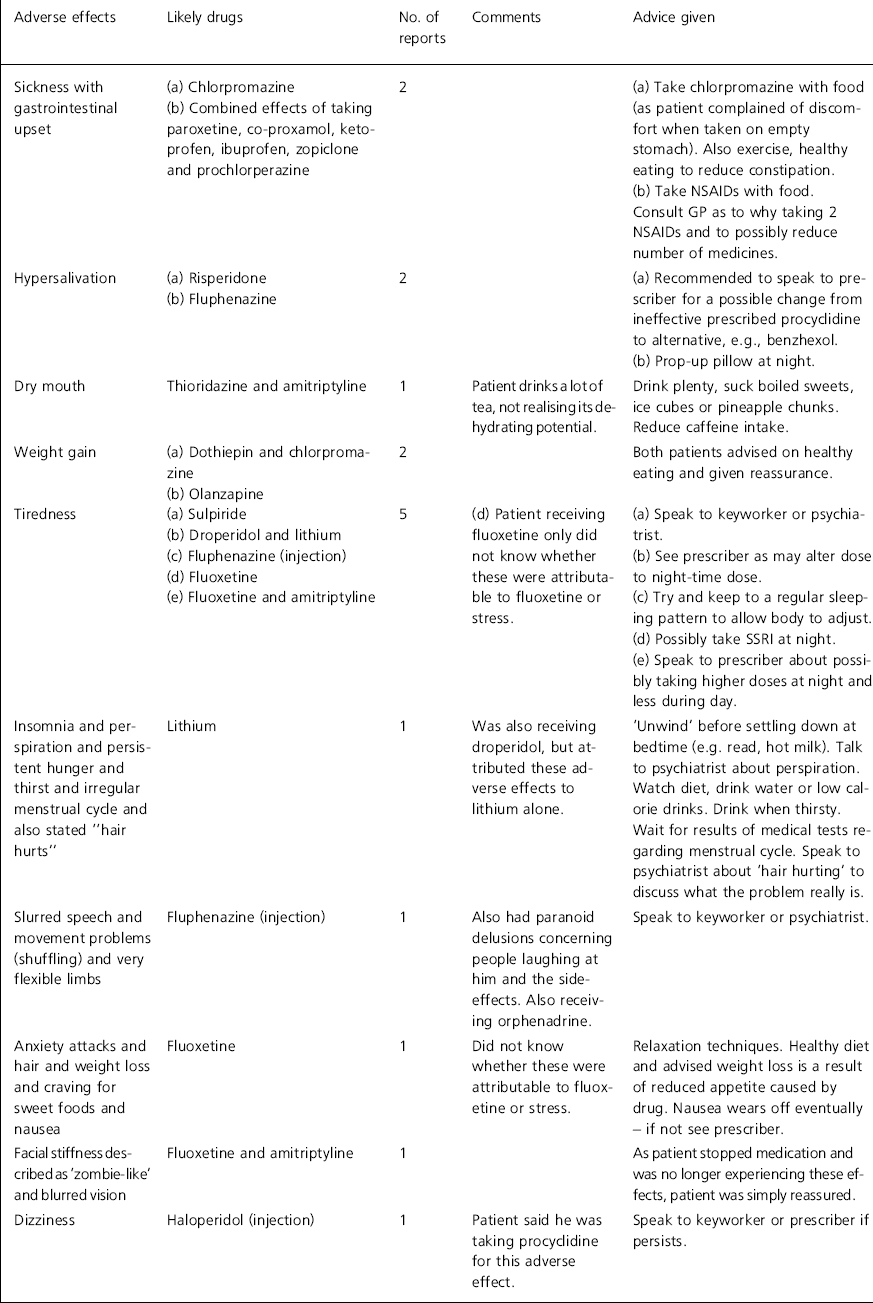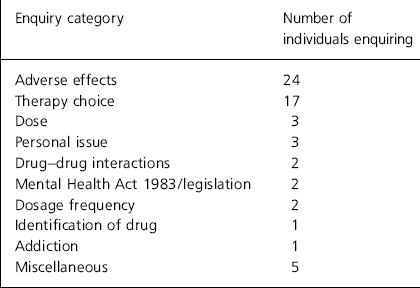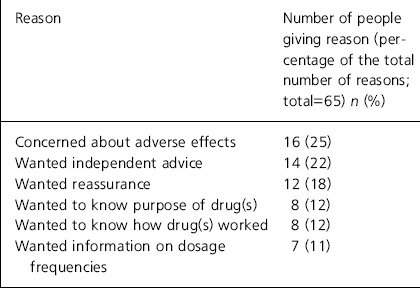Medication-related problems in the long-term mentally ill in the community can have far-reaching consequences. Research has shown that ‘patients have far more opportunities to fail to take their medication, whether intentional or otherwise' ’ if they are receiving medication for mental health problems outside the hospital setting (Reference DonoghueDonoghue, 1994). Two pilot studies on the contribution community pharmacists could make to the care of the long-term mentally ill (in Liverpool and Nottingham) have been reported (Reference DonoghueDonoghue, 1994; Nottinghamshire Family Health Services Authority, 1994; Reference Aldridge, Dingwall and WatsonAldridge et al, 1996; Reference WatsonWatson, 1997). The Liverpool community pharmacists provided specialist dispensing (e.g. adherence aids, instalment dispensing) and information services (e.g. to patients, day centre staff and carers). All found the service useful because community pharmacists were “more approachable than general practitioners” and gave impartial advice (Reference DonoghueDonoghue, 1993). The UK Psychiatric Pharmacy Group (UKPPG) produced a consensus statement in 1995 on the needs of the long-term mentally ill and how community pharmacists' intervention would help (UKPPG, 1997), including education and reassurance of patients and carers. As the majority of such patients receive primary care treatment, we decided to assess the role of community pharmacists in mental health resource centres.
The study
The aims of this service were to:
-
(a) answer queries about medication;
-
(b) assess patient response to and acceptance of the service.
Two mental health resource centres participated. Patients experienced a wide range of mental illnesses. Both centres offered regular services such as counselling, drugs and alcohol support, and social and educational activities. The community pharmacist-run advice service neither offered an opportunity to discuss the doctor's choice of therapy, nor provided a ‘Samaritans’-type counselling service. The community pharmacist aimed to offer confidential consultations in a friendly and independent manner. Where appropriate, patients were referred on to keyworkers, psychiatrists, specialist counselling services or telephone advice-lines. The service provided was free to both the patients and the resource centres. The community pharmacist received no remuneration for providing this pilot service. Sessions were held once a week for four consecutive weeks (duration 1-3 hours). Patients were seen on a first come, first served basis. A written record of each consultation was made, including patients' medication, adherence (self-reported), side-effects experienced and advice given. Patients and staff were given anonymous self-completion service evaluation questionnaires, after each consultation and at the end of the four-week service, respectively.
Findings
There were 33 consultations (including repeat visits) and 30 patients; this included a pair of concerned parents. Seventeen (52%) were female. The mean duration of the consultations was 14.9 minutes (range 5-45). Patients received a total of 72 prescribed drugs. Antipsychotics and antidepressants were the most common types of psychotropic medication received (18% and 15%, respectively). Non-psychotropic medication included: metered-dose asthma inhalers; analgesics; hormone replacement therapy; multivitamins; cardiovascular medication; antidiabetic therapy; and anti-arthritic therapy.
Sixty per cent of patients experienced side-effects. Examples are listed in Table 1. Sixty per cent said they were adherent to their medication. Reasons given for poor adherence included: forgetfulness; fear of taking or initiating treatment; ‘feeling better’; and side-effects.,
Table 1. Examples of adverse effects experienced and likely drugs, both as reported by users

| Adverse effects | Likely drugs | No. of reports | Comments | Advice given |
|---|---|---|---|---|
| Sickness with gastrointestinal upset |
|
2 |
|
|
| Hypersalivation |
|
2 |
|
|
| Dry mouth | Thioridazine and amitriptyline | 1 | Patient drinks a lot of tea, not realising its dehydrating potential. | Drink plenty, suck boiled sweets, ice cubes or pineapple chunks. Reduce caffeine intake. |
| Weight gain |
|
2 | Both patients advised on healthy eating and given reassurance. | |
| Tiredness |
|
5 | (d) Patient receiving fluoxetine only did not know whether these were attributable to fluoxetine or stress. |
|
| Insomnia and perspiration and persistent hunger and thirst and irregular menstrual cycle and also stated “hair hurts” | Lithium | 1 | Was also receiving droperidol, but attributed these adverse effects to lithium alone. | ‘Unwind’ before settling down at bedtime (e.g. read, hot milk). Talk to psychiatrist about perspiration. Watch diet, drink water or low calorie drinks. Drink when thirsty. Wait for results of medical tests regarding menstrual cycle. Speak to psychiatrist about ‘hair hurting’ to discuss what the problem really is. |
| Slurred speech and movement problems (shuffling) and very flexible limbs | Fluphenazine (injection) | 1 | Also had paranoid delusions concerning people laughing at him and the side-effects. Also receiving orphenadrine. | Speak to keyworker or psychiatrist. |
| Anxiety attacks and hair and weight loss and craving for sweet foods and nausea | Fluoxetine | 1 | Did not know whether these were attributable to fluoxetine or stress. | Relaxation techniques. Healthy diet and advised weight loss is a result of reduced appetite caused by drug. Nausea wears off eventually — if not see prescriber. |
| Facial stiffness described as ‘zombie-like’ and blurred vision | Fluoxetine and amitriptyline | 1 | As patient stopped medication and was no longer experiencing these effects, patient was simply reassured. | |
| Dizziness | Haloperidol (injection) | 1 | Patient said he was taking procyclidine for this adverse effect. | Speak to keyworker or prescriber if persists. |
Most enquiries concerned side-effects and choice of prescribed therapy (see Table 2). Queries about therapy choice included a patient with schizophrenia wanting to know if risperidone was ‘good’; a patient who had stopped taking antidepressants due to side-effects, wanting the pharmacist to recommend an antidepressant to suggest to his doctor; a patient wanting to know the difference in the mode of action between paroxetine, which she had previously been taking, and venlafaxine, which she was currently receiving. In cases where therapeutic judgement was questioned, the pharmacist either re-affirmed the prescriber's advice or recommended the patient discuss it further with the prescriber.
Table 2. Type of information requested(n=33)

| Enquiry category | Number of individuals enquiring |
|---|---|
| Adverse effects | 24 |
| Therapy choice | 17 |
| Dose | 3 |
| Personal issue | 3 |
| Drug-drug interactions | 2 |
| Mental Health Act 1983/legislation | 2 |
| Dosage frequency | 2 |
| Identification of drug | 1 |
| Addiction | 1 |
| Miscellaneous | 5 |
Patients usually volunteered their past medical history without prompting. One patient admitted attempted suicide with psychotropics, but was glad he had not been ‘successful’. Another patient with depression was concerned about the amount of co-proxamol tablets and antidepressants he was accumulating because he frequently had suicidal ideation. He was advised to take the excess medication to a community pharmacy for disposal. This facility had been unknown to him. In addition, he learned only on seeing the community pharmacist that co-proxamol contained paracetamol. He had been taking other paracetamol-containing products concurrently.
Evaluation of service
The questionnaires for patients and staff were similar and comprised mainly closed questions with the option of giving more detailed answers.
Patients
Twenty-seven (82%) patients responded. Some did not answer all the questions. Most patients gave more than one reason for using the advice service, indicating multiple unmet needs (see Table 3): Patients were mainly concerned about adverse effects and required independent advice. Twenty-four respondents were satisfied with the advice given by the community pharmacist. Only one respondent was not, explaining:
Table 3. Reasons for using the medication advice service(n=25)

| Reason | Number of people giving reason (percentage of the total number of reasons; total=65) n (%) |
|---|---|
| Concerned about adverse effects | 16 (25) |
| Wanted independent advice | 14 (22) |
| Wanted reassurance | 12 (18) |
| Wanted to know purpose of drug(s) | 8 (12) |
| Wanted to know how drug(s) worked | 8 (12) |
| Wanted information on dosage frequencies | 7 (11) |
“Helpful, but not totally, because I wanted to know whether I should take the tablets recommended by the psychiatrist, but probably the pharmacist just wasn't able to give such an opinion”.
This patient was wary of taking selective serotonin reuptake inhibitors suggested by his psychiatrist and preferred non-drug therapy. It seemed that the patient wanted his doubts supported. Obviously the community pharmacist was not in a position to do this.
All respondents found the service useful and all indicated the service was needed. Asked: “Has talking to the pharmacist helped you to understand your medicines better?” 24 respondents (92%) said ‘yes’. Reasons to support this included:
“(The pharmacist) provided useful information on medicines l'd been using for a long time without (me) being sure about side-effects”
“(The pharmacist) gave practical information on paper (referring to UKPPG patient information leaflets) that was quite useful. It is nice to know how medicines are affecting you”.
Only one of the 24 respondents said they would not like a service like this to be available permanently, but no reason was given. Twenty-two (88%; n=25) said they would miss the service when it is withdrawn. There were no unfavourable comments made about the quality of advice.
Staff
Seven staff who were in regular, direct contact with the patients completed the questionnaire. All believed the patients found the service useful. All indicated they would like a service like this to be available all the time. Reasons included:
“There is a clear unmet need in this area. To have the service available…would be very useful”.
“It gives confidence to service users on using appropriate medication”.
Six said they thought members would miss this service if it was no longer available.
Comment
The community pharmacist-run medication advice service was extensively used, the times allocated being fully utilised. Particularly noteworthy were the range of issues which worried patients, how much basic knowledge about their medication patients appeared to lack and the patients' appreciation of the community pharmacist's advice. It is also important to note that patients showed no reluctance to discuss their psychiatric problems with a community pharmacist. This perhaps justified the use of an independent pharmacist not directly involved in their treatment.
One important gap in patient knowledge concerned side-effects. Patients generally wanted to know how to manage them and whether they were serious.
Patients were told that the community pharmacist was not able to discuss therapy choice, but this was still the second most common enquiry made. This suggests that more patient involvement in the choice of drug treatment (the ‘therapeutic alliance’ (Working Party of the Royal Pharmaceutical Society of Great Britain, 1997)) may be needed in the prescribing process. Lack of an effective therapeutic alliance may result in ‘nonconcordance’, defined as”… failure of patient and prescriber to come to an understanding…” (Working Party of the Royal Pharmaceutical Society of Great Britain, 1997).
In the Liverpool and Nottingham studies, antipsychotics (38%) and antidepressants (31%) were also the two most common drug types enquired about. Similarly, in a 1996 Mind report on the launch of the first year of its Yellow Card Scheme, of 473 reports, it was also found that antipsychotics and antidepressants were most commonly reported (Mind, 1996). This reflects their common use but also perhaps patients' concerns about their usage.
Staff considered the service useful to those who used and needed it. No unfavourable comments were reported directly by users of the service or to staff. This was encouraging, because the service evaluation forms were completed anonymously.
From this small study we were unable to draw any reliable conclusions about the patients' adherence to treatment. Bonnar et al (Reference Bonnar, Goldberg and Smith1969) showed that patients tended to overestimate their level of adherence when checked by objective means. Subjective assessments of adherence by patients are partly dependent on the patient's honesty. Corrigan et al (Reference Corrigan, Lieberman and Engel1990) stated that up to 80% of patients receiving antipsychotics fail to take their medicines regularly. Donoghue (Reference Donoghue1993) found that 56% of 81 psychiatric patients had at some time abandoned their medication, and in a Canadian study of 148 psychiatric patients, 66% of patients altered the dose or frequency of administration without the advice of the prescriber (Reference Ruscher, De Wit and MazmanianRuscher et al, 1997). In addition, patients may be adherent with some aspects of treatment and not with others. Moreover, there is no single, agreed definition of ‘adherence’; it is a phenomenon extremely hard to define or quantify (Reference RaynorRaynor, 1992).
The community pharmacist found some queries difficult to answer. In such cases, patients were asked to speak to their keyworker or psychiatrist (e.g. two patients receiving antipsychotics complaining of hypersalivation, and a patient receiving haloperidol injections complaining of dizziness (see Table 1)). In such cases, patients were also given the telephone number of the Maudsley Hospital-based medication helpline. This help-line is run by specialist psychiatric pharmacists who have expertise, experience and access to up-to-date references. Thus, due to the limited knowledge and skills of even a specially-trained community pharmacist, it would probably be desirable for specialist psychiatric hospital pharmacists to oversee a service such as this as it would be likely that they would need to be consulted from time to time when the community pharmacist is challenged with more difficult queries.
Based on the results of this limited pilot study involving only 33 consultations and using only a single community pharmacist, the following recommendations may be made:
-
(a) More research is required to evaluate such services. It would be useful to know the extent to which patients followed the pharmacists' advice, and measure patient outcome.
-
(b) Community pharmacists should receive postgraduate training in mental health prior to becoming involved and should be remunerated for the service.
-
(c) All consultations should be documented for subsequent evaluation and for legal and ethical reasons.
-
(d) An informal pharmacist referral system could be set up, whereby patients could be referred to a pharmacist by other mental health team workers, or onwards to them by the pharmacist.
-
(e) Specialist psychiatric pharmacists should oversee the service.
Several limitations to this pilot study should be recognised:
-
(a) Only one community pharmacist adviser was used. Characteristics of the community pharmacist (e.g. gender, age, prestige, expertise, ethnicity (Reference Minichiello, Aroni and TimewellMinichiello et al, 1990) may have influenced the results (a form of ‘researcher bias’ (Reference Minichiello, Aroni and TimewellMinichiello et al, 1990)).
-
(b) To improve validity it would be necessary to repeat the study in more centres.
Acknowledgements
The authors would like to thank the staff at the two participating mental health resource centres for their help with the organisation of this pilot study, in particular, Michael Quinn, Libby Agate, Koku Adomdza and Nega Alem and to all the users. We are also grateful to Rose Echlin (Commissioner for Mental Health Services, Bexley & Greenwich Health Authority) for suggesting the service, and her support. Thank you to Shameem Mir and Barrat Luft at the Maudsley Hospital for the supply of UKPPG medication helpline cards and their interest in the service.






eLetters
No eLetters have been published for this article.